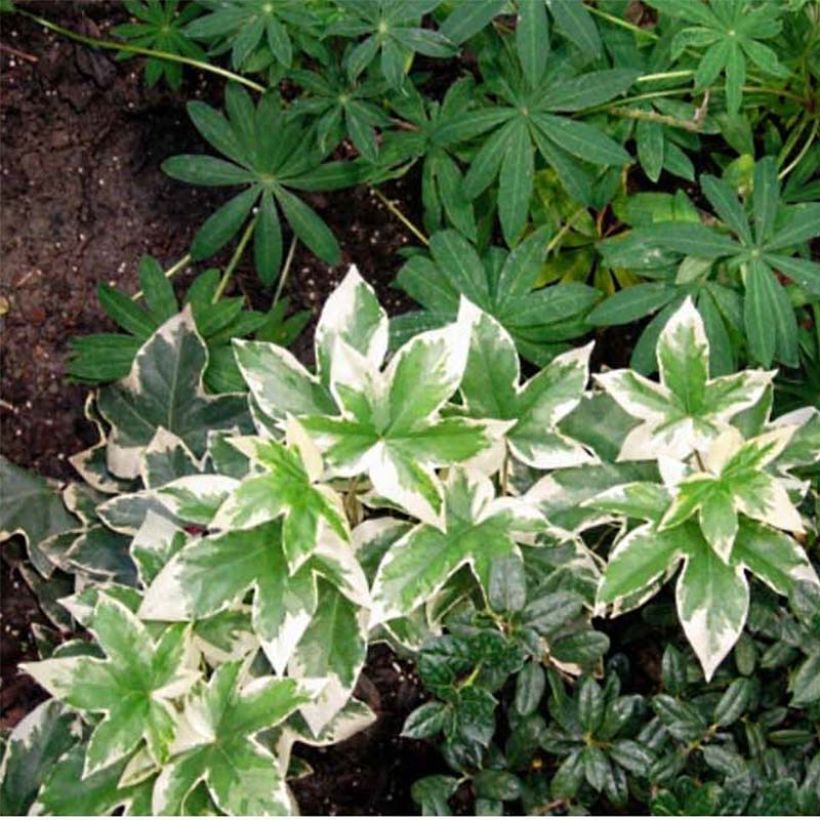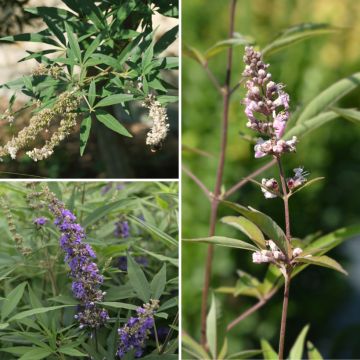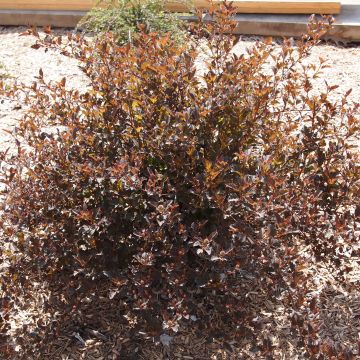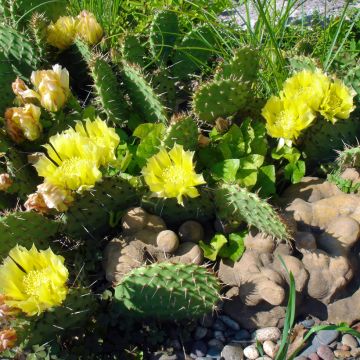

Fatshedera lizei Variegata - Lierre arborescent panaché
Fatshedera lizei Variegata
(x) Fatshedera lizei Variegata
Tree Ivy, Aralia Ivy
Special offer!
Receive a €20 voucher for any order over €90 (excluding delivery costs, credit notes, and plastic-free options)!
1- Add your favorite plants to your cart.
2- Once you have reached €90, confirm your order (you can even choose the delivery date!).
3- As soon as your order is shipped, you will receive an email containing your voucher code, valid for 3 months (90 days).
Your voucher is unique and can only be used once, for any order with a minimum value of €20, excluding delivery costs.
Can be combined with other current offers, non-divisible and non-refundable.
Why not try an alternative variety in stock?
View all →This plant carries a 24 months recovery warranty
More information
We guarantee the quality of our plants for a full growing cycle, and will replace at our expense any plant that fails to recover under normal climatic and planting conditions.
Would this plant suit my garden?
Set up your Plantfit profile →
Description
The Fatshedera lizei 'Variegata' is a compact and variegated foliage form of a hybrid between Fatsia japonica, or Japanese aralia, and the Hedera hibernica, the Irish ivy. The result is a small, elegantly climbing bush that bears large evergreen ivy leaves, variegated with green and white-cream. Often cultivated as a conservatory plant, the aralia-ivy can also be grown in the ground in mild regions. Plant it in a cool, humus-rich soil in partial shade to preserve the color of its foliage. It will bring a beautiful exotic touch to even the most modest decor.
Inspired gardeners from Nantes and lovers of exoticism, the Lizé brothers had the idea in 1912 to cross-breed the Fatsia japonica 'Moseri' and the Hedera helix subsp 'Hiberbica', both belonging to the same botanical family of Araliaceae. 'Variegata', which appeared later by chance and the play of spontaneous mutations, is distinguished by a more compact habit, reduced growth, and particularly bright foliage irregularly margined with white-cream.
This is a climbing shrub with a woody stump, with an upright or creeping bushy habit if supported. At maturity, this 'Variegata' form will reach an average height of 80 cm (31.5 in) with a spread of 70 cm (27.5 in). Its stems, unable to cling like those of ivy, bear large, tough, and thick leaves, measuring up to 20 cm (7.9 in) in diameter, evergreen in winter. Each leaf has a shiny lamina, dark green in color, variously maculated with more gray or lighter areas towards the center, and randomly margined with white-cream. Each leaf is deeply lobed into 5 lobes. Flowering sometimes occurs in November if the plant is not exposed to frost. It takes the form of small whitish flowers gathered in rounded bouquets resembling those of ivy. Occasionally, a few fruits may form.
Like its parent Fatsia japonica, Fatshedera lizei Variegata likes to be planted in partial shade, in cool, light, and rather acidic soil. While it can withstand, once mature, short frosts of around -10, or even -12°C (10.4 °F) in a very sheltered location, its foliage can be damaged by snow and winter winds. Place it in a highly protected spot, sheltered from cold, dry winds, as this will improve its hardiness. When discreetly supported, this arborescent ivy forms an elegant and unique subject, which will find its place in an exotic bed or in a Japanese-style garden. It can also be used as a bushy ground cover, alongside plants with lush foliage: rodgersias, fargesia or dwarf bamboos, hostas, silver candles, and Asarum maximum Giant, which thrive in the same environments. Cultivating it in a large pot presents no difficulty and will allow continental gardeners to shelter their variegated aralia-ivy in winter in the conservatory or in a bright and minimally heated room.
Report an error about the product description
Fatshedera lizei Variegata in pictures


Plant habit
Flowering
Foliage
Botanical data
(x) Fatshedera
lizei
Variegata
Araliaceae
Tree Ivy, Aralia Ivy
Cultivar or hybrid
Other Shrubs A to Z
View all →Planting and care
The Variegated Fatshedera lizei is grown in open ground in mild climates, or in pots to be stored indoors during winter elsewhere. It prefers slightly acidic soils, so it will be necessary to enrich your garden soil with leaf compost. Add a little coarse sand to improve drainage (beneficial in winter). Also, be careful to plant it in a sheltered location away from the wind and preferably in partial shade. Water well in summer to maintain some moisture at the base of the plant, in winter water minimally. It is wise during this period to protect it with frost fleecing if heavy frosts are forecasted. When the leaves of your aralia-ivy turn yellow in winter, it is often due to too low temperatures, in summer it is due to drought, so mist the plant with a little water. Prune any branches that you find unsightly in spring.
If you are growing in a pot, protect from heavy frosts in a veranda or a very bright, but minimally heated room: mist it once a week with non-calcareous water. Also, be on the lookout for the appearance of scale insects or mites, which find favorable conditions for their development in confined spaces.
Planting period
Intended location
Care
This item has not been reviewed yet - be the first to leave a review about it.
Similar products
Haven't found what you were looking for?
Hardiness is the lowest winter temperature a plant can endure without suffering serious damage or even dying. However, hardiness is affected by location (a sheltered area, such as a patio), protection (winter cover) and soil type (hardiness is improved by well-drained soil).

Photo Sharing Terms & Conditions
In order to encourage gardeners to interact and share their experiences, Promesse de fleurs offers various media enabling content to be uploaded onto its Site - in particular via the ‘Photo sharing’ module.
The User agrees to refrain from:
- Posting any content that is illegal, prejudicial, insulting, racist, inciteful to hatred, revisionist, contrary to public decency, that infringes on privacy or on the privacy rights of third parties, in particular the publicity rights of persons and goods, intellectual property rights, or the right to privacy.
- Submitting content on behalf of a third party;
- Impersonate the identity of a third party and/or publish any personal information about a third party;
In general, the User undertakes to refrain from any unethical behaviour.
All Content (in particular text, comments, files, images, photos, videos, creative works, etc.), which may be subject to property or intellectual property rights, image or other private rights, shall remain the property of the User, subject to the limited rights granted by the terms of the licence granted by Promesse de fleurs as stated below. Users are at liberty to publish or not to publish such Content on the Site, notably via the ‘Photo Sharing’ facility, and accept that this Content shall be made public and freely accessible, notably on the Internet.
Users further acknowledge, undertake to have ,and guarantee that they hold all necessary rights and permissions to publish such material on the Site, in particular with regard to the legislation in force pertaining to any privacy, property, intellectual property, image, or contractual rights, or rights of any other nature. By publishing such Content on the Site, Users acknowledge accepting full liability as publishers of the Content within the meaning of the law, and grant Promesse de fleurs, free of charge, an inclusive, worldwide licence for the said Content for the entire duration of its publication, including all reproduction, representation, up/downloading, displaying, performing, transmission, and storage rights.
Users also grant permission for their name to be linked to the Content and accept that this link may not always be made available.
By engaging in posting material, Users consent to their Content becoming automatically accessible on the Internet, in particular on other sites and/or blogs and/or web pages of the Promesse de fleurs site, including in particular social pages and the Promesse de fleurs catalogue.
Users may secure the removal of entrusted content free of charge by issuing a simple request via our contact form.
The flowering period indicated on our website applies to countries and regions located in USDA zone 8 (France, the United Kingdom, Ireland, the Netherlands, etc.)
It will vary according to where you live:
- In zones 9 to 10 (Italy, Spain, Greece, etc.), flowering will occur about 2 to 4 weeks earlier.
- In zones 6 to 7 (Germany, Poland, Slovenia, and lower mountainous regions), flowering will be delayed by 2 to 3 weeks.
- In zone 5 (Central Europe, Scandinavia), blooming will be delayed by 3 to 5 weeks.
In temperate climates, pruning of spring-flowering shrubs (forsythia, spireas, etc.) should be done just after flowering.
Pruning of summer-flowering shrubs (Indian Lilac, Perovskia, etc.) can be done in winter or spring.
In cold regions as well as with frost-sensitive plants, avoid pruning too early when severe frosts may still occur.
The planting period indicated on our website applies to countries and regions located in USDA zone 8 (France, United Kingdom, Ireland, Netherlands).
It will vary according to where you live:
- In Mediterranean zones (Marseille, Madrid, Milan, etc.), autumn and winter are the best planting periods.
- In continental zones (Strasbourg, Munich, Vienna, etc.), delay planting by 2 to 3 weeks in spring and bring it forward by 2 to 4 weeks in autumn.
- In mountainous regions (the Alps, Pyrenees, Carpathians, etc.), it is best to plant in late spring (May-June) or late summer (August-September).
The harvesting period indicated on our website applies to countries and regions in USDA zone 8 (France, England, Ireland, the Netherlands).
In colder areas (Scandinavia, Poland, Austria...) fruit and vegetable harvests are likely to be delayed by 3-4 weeks.
In warmer areas (Italy, Spain, Greece, etc.), harvesting will probably take place earlier, depending on weather conditions.
The sowing periods indicated on our website apply to countries and regions within USDA Zone 8 (France, UK, Ireland, Netherlands).
In colder areas (Scandinavia, Poland, Austria...), delay any outdoor sowing by 3-4 weeks, or sow under glass.
In warmer climes (Italy, Spain, Greece, etc.), bring outdoor sowing forward by a few weeks.




























































